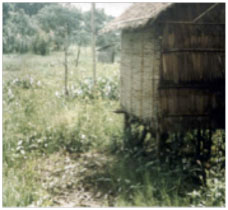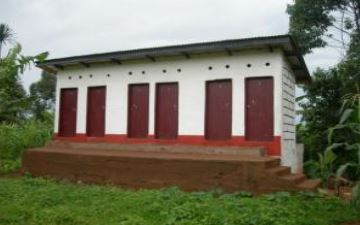1) What is involved ?
These are specific models of buried single-pit, and sometimes twin-pit toilets or slightly elevated toilets built to meet specific needs, situations or configurations in the field such as hard soils, wetlands or floodplains. Their use is thus less common.
There are more especially four types : twin-pit latrines, raised pit or backfill latrines, borehole latrines and suspended latrines.
2) General characteristic of their pits, slabs and superstructures
Other than their specificities described below, these latrines are quite similar to those described in fact sheet A6 on dry, simple, single-pit latrines which you are advised to refer to.
3) Types of latrines concerned
(Most of sketches below provided by WEDC, University of Loughborough, UK, others by OMS)
a) Twin-pit latrines
Be careful not to confuse these latrines with latrines sometimes mistakenly referred to using the same name as also dug by making two holes but much shallower as their pits are only semi-buried, or with latrines which have two above-ground compartments. These latrines are actually twin receptacle latrines, often referred to as twin-compartment latrines, primarily used for making ECOSAN ecological, compost making type latrines (Fact sheet A9)
 Process
Process
Is almost the same as for single-pit latrines. It involves digging two adjoining pits or two pits close to one another.
Another technique involves, to avoid having to move the superstructure, placing it not above but in front of the two pits, which makes them also more convenient to drain, and connecting it to the pit by two pipes, or more rarely a removable hose.
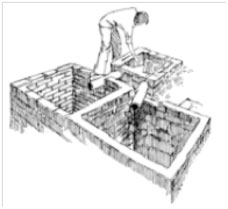 Specificities of use/ Advantages
Specificities of use/ Advantages
These latrines are much less common than single-pit latrines and can be easier or more useful to build :
- either when the ground is quite hard and it is less difficult to dig two side-by-side pits with a smaller capacity than a deep pit.
- or conversely when the ground is quite soft and a fairly deep hole can be dug so as to be able to use the two pits alternately, either or have enough time needed to drain the one that is full, or let it sit for a year or two and then make compost, rather than having to dig a new hole each time the pit is full
In both cases, it is preferable to provide a lightweight superstructure that can be easily moved.
Cost
Generally varying from €100 to 160 depending on the model and the region.
b) Raised pit latrines
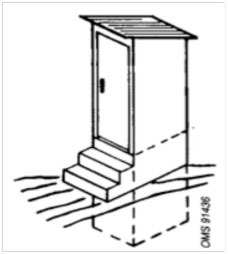
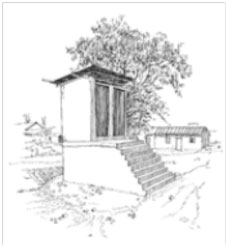 This type of latrine is more appropriate in situations where :
This type of latrine is more appropriate in situations where :
- either water table is close to the ground surface,
- or the ground is hard and difficult to dig
Process
Involves digging a pit part of which is not buried but raised by building a low elevation compartment made of concrete or plaster. For this purpose, a hole of adequate depth is dug while the ground is not too hard, but not deep enough to reach the groundwater level.
This pit is then extended height-wise by building a lightweight plaster casing on its walls up to the height required to obtain the desired volume of the pit. Attention should, however, be given to difficulties of access for the elderly or disabled (in the same way as for the following variant).
 Other variant : latrine on backfill
Other variant : latrine on backfill
If the surface and quality of infiltration of the underground pit is insufficient, it is preferable to surround the upper part of the pit by infiltration backfill up to about 50 cm from the top edge, consisting of permeable, well compacted soil. This bank should be stable and thick enough to prevent any seepage on the sides.
Care should be taken, however to avoid building earthen embankments on clayey soils, as the lack of infiltration into the soil can lead to seepage
Main Advantages/Disadvantages
- Much easier to build on hard ground.
- A latrine can be built even with a high water table.
- They are, however, slightly more complicated and expensive to build.
c) Borehole latrines
This type of latrine is mainly distinguished by the pit digging technique : by drilling and not simply by digging.
Although it is not used all that much, it is sometimes in urgency situations used when adequate drilling means are available.
Process
Although major drilling facilities can be used, use can also simply be made of an auger, which is a sort of helical screw. Holes are generally small in diameter (30-50 cm) and usually about 5 m deep, which may be sufficient for a family of 5 people for a period of 2 or 3 years. Although they may be up to 10 m deep, there may then be a greater risk of contamination of groundwater. Similarly, the diameter may be smaller, to make drilling easier, but there is then a risk of pit clogging and shorter service life.
Even if there is no obstruction, walls are dirty near the top and hence make for a risk of fly infestation. That is why these latrines should be restricted to urgency situations for as short a period as possible.
It is recommended to line the holes at least over the first 50 cm with an impervious material (concrete or fired clay).
Main Advantages/Disadvantages
- Faster to build if the soil is fairly loose
- Sometimes better suited to urgency situations
- But risk of obstruction, fly infestation and fairly short service life.
d) Suspended latrines
These are in particular better suited to wetlands or floodplains.
These are latrines, the floor of which is located above wetlands or floodplains, or the level of a river, which may nevertheless, through lack of precautions, pose public health and safety problems.
They should only be used if no other means are available and if no other type of latrine is available in the region during critical periods.
Process A squat hole is located in the raised floor. It allows faeces :
A squat hole is located in the raised floor. It allows faeces :
 - either to fall into a container or receptacle installed between the floor and the ground where, moreover, a pit will have been carefully dug during the dry season,
- either to fall into a container or receptacle installed between the floor and the ground where, moreover, a pit will have been carefully dug during the dry season,
- or to fall directly into the water, although this method is not recommended due to the risk of contamination of the water and populations downstream.
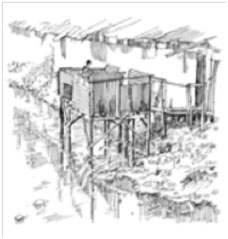 This type of latrines should thus not be installed, especially over a river, when normal pit latrines can be installed. However, they are sometimes the only practical sanitation solution in the case of wetlands or floodplains, in which case care must be taken to ensure that access ways, piles, squat holes and stalls are built to ensure the safety of adults and children, and that a receptacle has effectively been provided at a sufficient depth,
This type of latrines should thus not be installed, especially over a river, when normal pit latrines can be installed. However, they are sometimes the only practical sanitation solution in the case of wetlands or floodplains, in which case care must be taken to ensure that access ways, piles, squat holes and stalls are built to ensure the safety of adults and children, and that a receptacle has effectively been provided at a sufficient depth,
with an impervious receptacle between the latrine floor and the ground
Main advantages and drawbacks
- Only standalone means of sanitation available in some areas or seasons
- But difficult to build, risks of contamination from leaking pits and lightweight structures posing safety problems.
4) Where to obtain further information ?
a) Bibliography
- WHO (World Health Organization) in Geneva : Individual sanitation guide by Franceys R., Pickford J. and Reed R., 1995
- Action against Hunger : "Water - Sanitation - Hygiene for populations at risk"
Comprehensive book containing 745 pages published by Hermann 6 rue de la Sorbonne 75006 Paris (€50) explaining and illustrating the various techniques used by ACF and pages 435 to 442 of which cover dry latrines.
b) Videos
- Encyclopaedia : 7’ video entitled "Double vault latrine construction" without any voice commentary but providing a very good illustration of how to make a twin-pit latrine here in Asia. Available on line at :
http://www.encyclopedia.com/video/p...
- YouTube : 10’ video shot in Niger entitled "Building latrines" during a demonstration of the building of an ecological latrine in eight villages, available online at :
http://www.ecosanres.org/aguie/film...
- YouTube : another 7’ video on the same subject "Double vault latrine construction" http://www.youtube.com/watch?v=p0yc...



